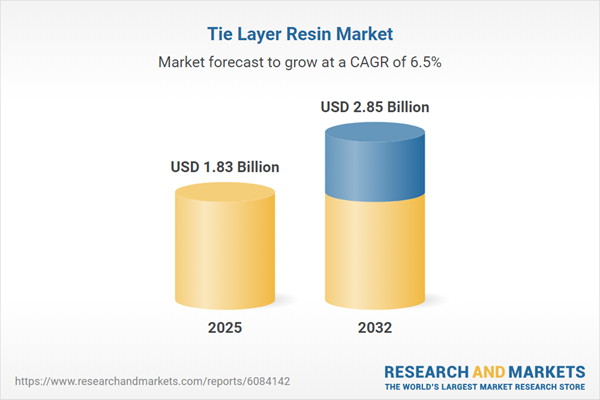Speak directly to the analyst to clarify any post sales queries you may have.
The tie layer resin market is evolving rapidly as industries pursue higher-performance multilayer film structures, balancing product innovation with the need for enhanced sustainability and operational resilience. This report provides senior leaders with actionable guidance to navigate new market dynamics and capitalize on strategic growth and efficiency opportunities.
Market Snapshot: Tie Layer Resin Market Growth and Outlook
The tie layer resin market grew from USD 1.71 billion in 2024 to USD 1.83 billion in 2025 and is projected to expand at a CAGR of 6.54%, reaching USD 2.85 billion by 2032. This positive outlook reflects advancing adoption across packaging, automotive, electronics, and medical industries. Market growth is driven by a sustained focus on high-barrier multilayer film demand, innovation in polymer chemistry, and evolving regulatory pressures encouraging new material solutions.
Scope & Segmentation
This report analyzes the tie layer resin market by application, industry segment, resin type, and geography. Coverage spans critical areas shaping demand, product development, and competitive positioning.
- End Use Industry: Automotive (exterior and interior lamination), electronics (display panels and flexible printed circuits), medical (biomedical devices and medical packaging), and packaging (consumer goods, food, and pharmaceutical packaging).
- Application: Adhesive films for lamination, coating processes for surface modifications, extrusion for integrated barriers, and laminated film combinations.
- Resin Type: Ethylene vinyl acetate resins (fully and partially neutralized), ionomer resins (Surlyn A, Surlyn B), and metallocene polyethylenes (linear and very low density grades).
- Geography: Americas (United States, Canada, Mexico, Brazil, Argentina, Chile, Colombia, Peru), Europe, Middle East, and Africa (including United Kingdom, Germany, France, Russia, Italy, Spain, Netherlands, Sweden, Poland, Switzerland, United Arab Emirates, Saudi Arabia, Qatar, Turkey, Israel, South Africa, Nigeria, Egypt, Kenya), and Asia-Pacific (China, India, Japan, Australia, South Korea, Indonesia, Thailand, Malaysia, Singapore, Taiwan).
- Key Companies: The Dow Chemical Company, Eastman Chemical Company, BASF SE, Arkema S.A., Evonik Industries AG, DIC Corporation, Borealis AG, LyondellBasell Industries N.V., Mitsubishi Chemical Corporation, and Kraton Corporation.
Key Takeaways for Senior Decision-Makers
- Modern tie layer resin technology is critical in optimizing the adhesion and compatibility of dissimilar polymer layers, empowering the creation of versatile, high-performance multilayer materials.
- Recent advances in bio-based systems and recycled content enable compliance with evolving regulatory and sustainability standards, while preserving required adhesion properties in complex structures.
- Collaborative innovation—between resin producers, equipment manufacturers, and end users—accelerates market introduction of specialty grades tailored to stringent end-use requirements, such as flexible electronics and medical devices.
- Emerging process control techniques, including in-line monitoring and digitalization, drive higher production consistency, reduced waste, and better predictive management for complex multilayer film manufacturing.
- Strategic expansion of compounding capacity and alignment with downstream lamination partners enhance supply chain resilience, facilitating rapid response to shifts in regional demand and regulations.
Tariff Impact: Implications for Sourcing and Supply Chain Strategy
Recent United States tariff measures on polyethylene copolymers and ionomer resins are changing global sourcing patterns. Many organizations are reassessing supply chains by exploring nearshoring, restructured logistics, and flexible procurement agreements to manage cost volatility and maintain operational reliability.
Methodology & Data Sources
Our research combines primary interviews with material scientists, procurement leaders, and engineers, alongside secondary analysis of industry publications, regulatory filings, and patents. Rigorous triangulation and value chain mapping ensure reliable, actionable insights with direct relevance to end-user needs.
Why This Report Matters
- Equips executives to anticipate and respond to regulatory, supply chain, and sustainability pressures through detailed market segmentation and analysis.
- Supports informed investment and sourcing decisions by examining region- and sector-specific trends, technology adoption, and key supplier actions.
- Enables proactive innovation and operational strategies, fostering competitive advantage in automotive, flexible packaging, and high-growth electronics segments.
Conclusion
This report offers a concise roadmap for navigating ongoing change in the tie layer resin market. Strategic adaptation and innovation will be vital for capturing future opportunities and ensuring operational resilience in a dynamic industry landscape.
Table of Contents
3. Executive Summary
4. Market Overview
7. Cumulative Impact of Artificial Intelligence 2025
Companies Mentioned
The companies profiled in this Tie Layer Resin market report include:- The Dow Chemical Company
- Eastman Chemical Company
- BASF SE
- Arkema S.A.
- Evonik Industries AG
- DIC Corporation
- Borealis AG
- LyondellBasell Industries N.V.
- Mitsubishi Chemical Corporation
- Kraton Corporation
Table Information
| Report Attribute | Details |
|---|---|
| No. of Pages | 184 |
| Published | October 2025 |
| Forecast Period | 2025 - 2032 |
| Estimated Market Value ( USD | $ 1.83 Billion |
| Forecasted Market Value ( USD | $ 2.85 Billion |
| Compound Annual Growth Rate | 6.5% |
| Regions Covered | Global |
| No. of Companies Mentioned | 11 |









